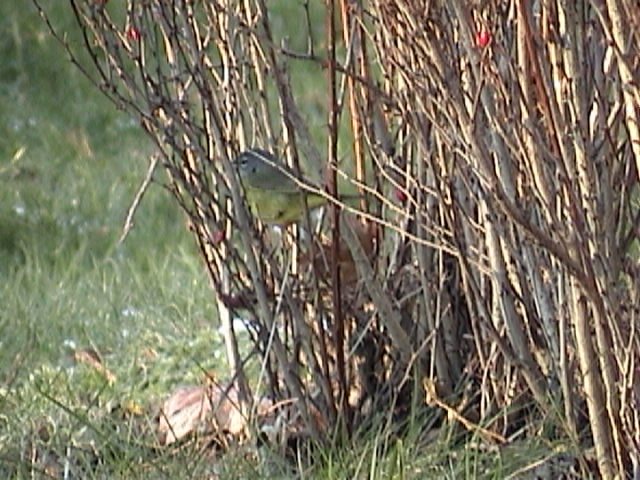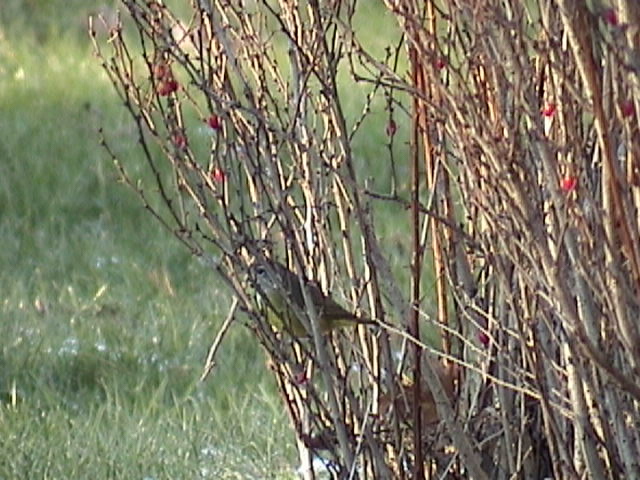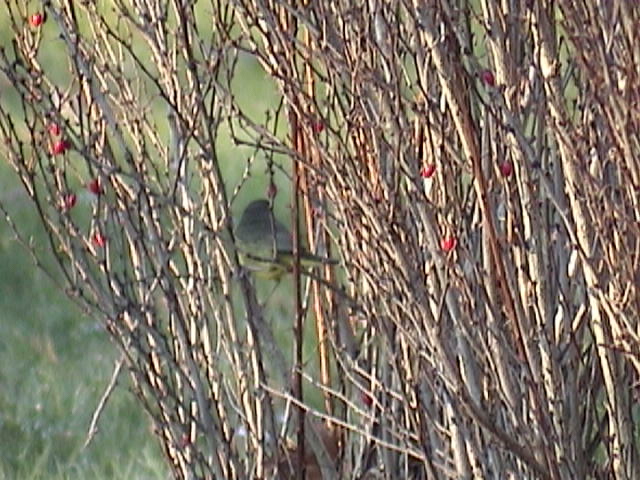



Illustrated here are four images of a MacGillivray's Warber (Oporornis tolmiei) photographed on December 4, 2000 in Halifax, Nova Scotia, Canada. The bird was first discovered in the area on November 20 and stayed in the vicinity until December 7 when cold weather caused it to disappear. This is the first record for this species in Nova Scotia and all of Atlantic Canada.
In a couple of the photographs the bright and broken eye-ring can be seen quite distinctly. The throat is clearly gray with no visible (or suffused) yellow and the breast band is distinct, all characters which indicate a MacGillivary's Warbler. The long tail and extension of tail past the undertail coverts has also noted by some observers (Angus MacLean). The bird has a charp and penetrating "ticking" call which it repeats, quite unlike that of the Mouning Warbler (Oporornia philadelphia).
Photographs by Christopher Majka.
The bird was often seen in the barberry hedge which runs along the front and west side of 6667 Jubilee Road. I observed it feeding by moving along the length of the hedge, also moving to the forsythia bush that is in the front yard. From there it several times moved to a large hedge that is in the back yard of 1720 Bloomingdale Terrace. The back yard of this house is separated from the previous by a large stone wall and it perches there, flying in an out of the hedge. It also forgaed low down amongst the lower limbs of the lilac bushes that separate the two yards.
I an other observers saw it searching for food in the shrubbery adjacent to the railroad tracks which run beside this property. It has also been seen at 1657 Fairfield Street around the corner, moving and feeding along the hedge which separates that property from the tennis courts at the St. Mary's Boat Club.
According to Peterson's Field Guide to Western Birds the breeding range is:
Range: Breeds from SE Alaska, SW Yukon, N. BC, S Alberta, SW Saskatchewan, south to central California (coast and mountains) and in mountains south to Nevada, central Arizona, and central New Mexico. In migration E to western edge of Plains and Edward's Plateau (Texas). Winters Mexico to Columbia; rarely California.Voice: Song a rolling chiddle-chiddle-chiddle, turtle-turtle, voice dropping on last notes; or sweeter-sweeter-sweeter, sugar-sugar. Also chiddle-chiddle-chiddle, wick-wick.
Earl Godfrey's Birds of Canada gives the range as:
Range in Canada :Breeds in extreme southwestern Yukon; British Columbia,; southern Alberta; and extreme southwestern Saskatchewan. Recorded eastward in Saskatchewan to Wood Mt. Accidental in Ontario.Range: Breeds from southeastern Alaska, northern British Columbia, southern Albert, and southwestern Saskatchewan south to central California, central Arizona, and central New Mexico. Winters from northern Mexico south to Panama.
Song Three or four quick notes in the same pitch, followed by several lower notes: see it, see it, see it, peachy, peachy.